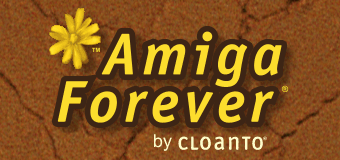A: The
Amiga Explorer networking software, which is part of Amiga Forever, connects an
Amiga to one or more Windows computers, showing the contents of all Amiga drives on the Windows Desktop (see picture). "Drag and drop" of Amiga files
becomes as easy as moving files on the local machine. Amiga Explorer usually
requires just one setting to be configured (the COM port to which
the Amiga is attached, or the IP address of a networked Amiga),
and provides support for Amiga and emulation-specific features
(e.g. virtual ADF, HDF and ROM files).
The freely distributable Samba
software, which runs on top of TCP/IP, does provide a very good
degree of bi-directional networking capabilities, but it is much
more difficult to set up and configure than Amiga Explorer. Other commercial solutions we
are aware of, including the Siamese System,
and the NFS Amiga client included with
AmiTCP/IP (that can be used with NFS servers such as the one
included with Microsoft's
Windows Services
for Unix, from
Intergraph/SSC
and
others), do the opposite of Amiga Explorer, by making PC files
available to the Amiga side.
With Amiga Explorer, the Amiga side acts as a server, i.e. the
Amiga drives are seen on the Windows Desktop (but the opposite is
not true, i.e. Windows drives do not appear on the Amiga
Workbench), and configuration requires the setting of a single
value (serial speed, or IP address of the Amiga). Also, by
implementing a high-level Windows namespace extension model, Amiga
Explorer can pack several requests for data (e.g. to view the
contents of a directory) into a single request to the Amiga and a
single reply from the Amiga, improving the response time compared
to data transfer solutions working at the file system level.
This is especially useful when connecting two computers over a
serial cable, which does not provide a connection as fast as
Ethernet, for example.
The Siamese System, which is not available any more, provided a
very interesting approach to Amiga-PC integration. This
combination of hardware and software resulted in the Amiga (a
"real" Amiga with a Siamese network card) becoming a terminal
server, with the Amiga screen being rendered on the PC, on which
the client software was running. The Siamese software, written by
Paul Nolan, excelled in reducing the required bandwidth, for
example by transmitting instructions for high level actions
(rather than simply refreshing entire bitmap regions) wherever
possible, however while providing support for RTG screen modes it
was not compatible with the original Amiga screen modes. The same
functionality originally provided by the Siamese System can now
easily be provided by an emulation package like
Amiga Forever, which is
faster, more compatible, and does not require an Amiga to be
connected to the PC.
Before software
emulation of Amiga hardware became popular, several other,
hardware-based, Amiga-PC integration concepts and prototypes were
released. One of the most interesting ones was the Access
Amiga-on-a-board ISA card by Mick Tinker and Steve Rencontre.
Unfortunately these boards never enjoyed any commercial success.
Besides being more expensive than a low end Amiga computer, they
required an additional monitor to be connected to the PC in order
to display native Amiga screen modes. Also, as original Amiga
components and spare parts were getting older and more difficult
to find, it was hard to provide the quality and support that
computing customers were getting accustomed to. In comparison with
hardware-based solutions, emulation has the additional advantage
of being upgradeable and reconfigurable to emulate a certain CPU
or RAM configuration, if required for compatibility reasons.
Related Links


